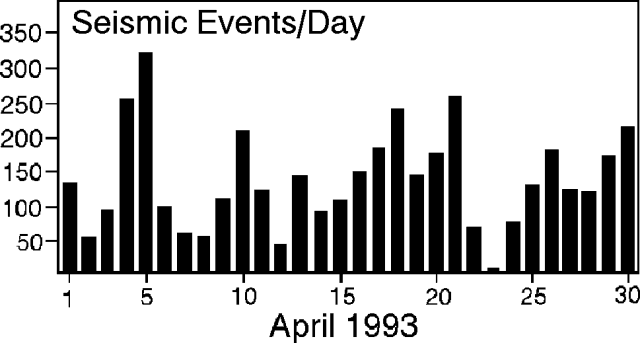Report on Poas (Costa Rica) — April 1993
Bulletin of the Global Volcanism Network, vol. 18, no. 4 (April 1993)
Managing Editor: Edward Venzke.
Poas (Costa Rica) Fumarolic activity continues; lake level drops
Please cite this report as:
Global Volcanism Program, 1993. Report on Poas (Costa Rica) (Venzke, E., ed.). Bulletin of the Global Volcanism Network, 18:4. Smithsonian Institution. https://doi.org/10.5479/si.GVP.BGVN199304-345040
Poas
Costa Rica
10.2°N, 84.233°W; summit elev. 2697 m
All times are local (unless otherwise noted)
Fumarolic activity in the N part of the crater lake continued in April as gas columns rose to 500 m. One fumarole produced a jet-like sound, audible from an observation site 1 km S. Almost constant phreatic eruptions produced 1-2-m-high plumes in a light-green area near the center of the lake. The lake level dropped 1 m during April.
A seismograph located 2.7 km SW of the active crater recorded 4,115 low-frequency events (2-2.5 Hz) during April (figure 44). The highest daily total of the month was 319 on 5 April.
 |
Figure 44. Seismic events/day recorded 2.7 km SW of the main crater of Poás, April 1993. Courtesy of OVSICORI. |
Geological Summary. The broad vegetated edifice of Poás, one of the most active volcanoes of Costa Rica, contains three craters along a N-S line. The frequently visited multi-hued summit crater lakes of the basaltic-to-dacitic volcano are easily accessible by vehicle from the nearby capital city of San José. A N-S-trending fissure cutting the complex stratovolcano extends to the lower N flank, where it has produced the Congo stratovolcano and several lake-filled maars. The southernmost of the two summit crater lakes, Botos, last erupted about 7,500 years ago. The more prominent geothermally heated northern lake, Laguna Caliente, is one of the world's most acidic natural lakes, with a pH of near zero. It has been the site of frequent phreatic and phreatomagmatic eruptions since an eruption was reported in 1828. Eruptions often include geyser-like ejections of crater-lake water.
Information Contacts: E. Fernández, J. Barquero, V. Barboza, and W. Jimenez, OVSICORI.

